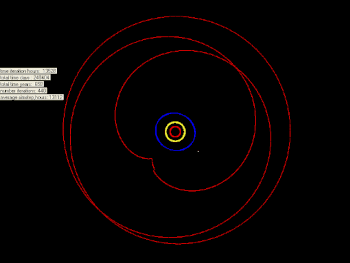| Discovery | |
|---|---|
| Discovery date | 2003 |
| Designations | |
| 2003 LA7 | |
| 1:4 resonance[1][2] | |
| Orbital characteristics[3] | |
| Epoch 13 January 2016 (JD 2457400.5) | |
| Uncertainty parameter 3 | |
| Observation arc | 1746 days (4.78 yr) |
| Aphelion | 116.44 AU (17.419 Tm) (Q) |
| Perihelion | 36.002 AU (5.3858 Tm) (q) |
| 76.220 AU (11.4023 Tm) (a) | |
| Eccentricity | 0.52765 (e) |
| 665.45 yr (243054 d) | |
| 346.07° (M) | |
| 0° 0m 5.332s /day (n) | |
| Inclination | 5.6369° (i) |
| 34.076° (Ω) | |
| 271.47° (ω) | |
| Earth MOID | 34.9906 AU (5.23452 Tm) |
| Jupiter MOID | 30.912 AU (4.6244 Tm) |
| Physical characteristics | |
| Dimensions | ~231 km (assumed)[4] |
| 0.09 (assumed) | |
| ~22.4[5] | |
| 6.5[3] | |
2003 LA7, also written as 2003 LA7, is a resonant trans-Neptunian object that goes around the Sun once for every four times that Neptune goes around. This means it is in a 1:4 orbital resonance with Neptune. Another example of such object in this resonance is 2011 UP411.
Orbit  The orbit of "fourtino" 2003 LA7 compared to Pluto and Neptune. |
1:4 Libration  Neptune is held stationary at 5 o'clock. |
2003 LA7 is in a 1:4 resonance with the planet Neptune.[1][2] For every one orbit that a it makes, Neptune orbits 4 times.
It is currently 43 AU from the Sun,[5] and will come to perihelion around 2041.[3]
Assuming a generic TNO albedo of 0.09, it is about 231 km in diameter.[4]
It has been observed 14 times over 4 oppositions.[3]
- ^ a b "MPEC 2009-C70 :Distant Minor Planets (2009 FEB. 28.0 TT)". Minor Planet Center. 10 February 2009. Retrieved 14 March 2009.
- ^ a b Marc W. Buie. "Orbit Fit and Astrometric record for 03LA7" (last observation: 2008-03-12 using 17 of 18 observations). SwRI (Space Science Department). Retrieved 13 October 2014.
- ^ a b c d "JPL Small-Body Database Browser: (2003 LA7)" (last observation: 2007-04-21). Retrieved 30 March 2016.
- ^ a b Wm. Robert Johnston (22 August 2008). "List of Known Trans-Neptunian Objects". Johnston's Archive. Archived from the original on 13 February 2009. Retrieved 14 March 2009.
- ^ a b "AstDys 2003LA7 Ephemerides". Department of Mathematics, University of Pisa, Italy. Archived from the original on 26 May 2011. Retrieved 19 March 2009.